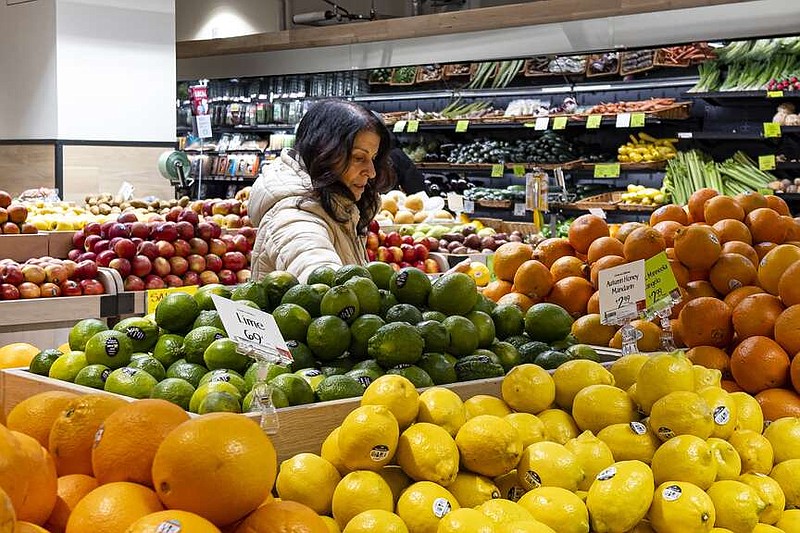The federal program that helps pay for groceries for millions of low-income mothers, babies and young children will soon emphasize more fruits, vegetables and whole grains, as well as provide a wider choice of foods from different cultures.
The final rule changes for the program known as WIC were announced Tuesday by the Food and Nutrition Service and will take effect within two years with some exceptions.
Last updated a decade ago, the new WIC rules make permanent a bump in monthly cash vouchers for fruits and vegetables -- something first enacted during the covid-19 pandemic. Shoppers can also add canned fish, fresh herbs and lactose-free milk to their carts, among other changes. The voucher piece will take effect by June, officials said.
"It places a heavy emphasis on fruits and vegetables, which we think is an important component of a healthy diet," Agriculture Secretary Tom Vilsack said in an interview. "It's designed to fill the nutrition gaps that are often in the diets of many of us."
"These improvements to our food packages have the potential to make positive, lifelong impacts on health and well-being," Cindy Long, the administrator for the Agriculture Department's Food and Nutrition Service, said in a statement
The WIC program served an average of about 6.6 million low-income Americans a month in 2023 at a cost of a little more than $7 billion with an average monthly cost of $56 per person. It's designed to supplement the food budgets for pregnant, nursing and postpartum women, as well as to feed babies and young kids up to age 5. That's done by providing vouchers to mothers and children who qualify and specifically listing the amount and types of food they can buy.
To be eligible, a participant's family income cannot exceed more than 185% of the federal poverty level, or about $37,800 for a family of two. But officials have said only about half of those eligible are enrolled in the Supplemental Nutrition Program for Women, Infants and Children.
Under the new rules, fruits and vegetable vouchers in 2024 will provide $26 per month for kids ages 1 through 4; $47 per month for pregnant and postpartum women; and $52 for breastfeeding women. The changes also expand access to whole grains like quinoa, wild rice and millet and to foods such as teff and whole wheat naan. They also remove or reduce monthly allowances for juice.
Those updates align with findings from a survey released Tuesday from the National WIC Association, a nonprofit that advocates on behalf of recipients. Of 22,000 participants in WIC, 93% said the cash voucher for fruit and vegetables was the top reason they enrolled and more than 90% said the value of those vouchers was just right or not enough.
Under the new rule, the program will also reduce the amount of milk it provides for fully breastfeeding women, from a monthly maximum of 6 gallons to 4 gallons; from 4 gallons to 3.5 gallons for children ages 2 to 4; and from 4 gallons to 3 gallons for toddlers. At the same time, participants can now substitute plant-based and lactose-free products for dairy or increase the amount of yogurt.
After the Agriculture Department proposed the rule change in November 2022, the cuts to milk elicited backlash from the dairy industry and members of Congress.
The department, in explaining the change, contended that the previous amounts of milk equated to 128% of the daily amount recommended by nutrition guidelines, while the updated amounts equated to 71% to 96% of the recommended amount.
The International Dairy Foods Association and the National Milk Producers Federation, groups that represent the industry and dairy farmers, expressed disapproval at the final reductions but voiced support for the expansion in substitutions.
Gregg Doud, the federation's president, said in a statement that it was "disturbed by the decision to reduce access to the essential nutrients dairy adds to the diet."
Georgia Machell, the interim president and CEO of the National WIC Association, welcomed the overall changes.
The group "applauds USDA for adhering to an independent, science-based review process that led to these stronger standards," she said in a statement.
The new rule also requires breakfast cereals containing 75% whole grain -- a reduction from the proposed rule's requirement that it adhere to dietary guidelines' recommendation of 100% whole grain. It also reduced the amount of juice provided.
Food plans in the program are based on recommendations from the National Academies of Science, Engineering and Medicine and the federal 2020-2025 Dietary Guidelines for Americans.
The plan failed to include a change requested by top allergists in the U.S. that would have added peanut products to foods allowed for babies ages 6 months to 11 months to help prevent peanut allergies.
Research published in 2015 showed early introduction to peanut foods can reduce the chance of allergy development in kids who are at high risk, and several U.S. guidelines suggest exposing high-risk children to peanuts as early as 4 months.
Adding peanut to the WIC guidelines may have prevented more than 34,000 infants from developing a peanut allergy, said Dr. Gideon Lack of King's College London, who led the study. But federal nutrition officials concluded that the change was "outside the scope" of the final rule.
Dr. Ruchi Gupta, a pediatrics professor and child allergy expert at Northwestern University, called the omission "disappointing." She noted that WIC enrollees often include children of color who are at higher risk of developing dangerous peanut allergies.
The decision "can only increase disparities we are already seeing in food allergy prevalence," she said.
Information for this article was contributed by Jonel Aleccia of The Associated Press and by Linda Qiu of The New York Times.
